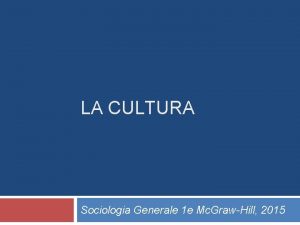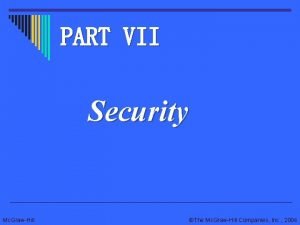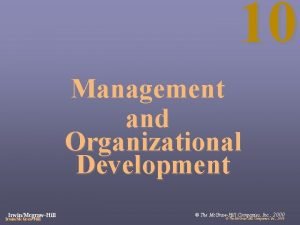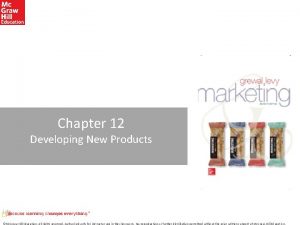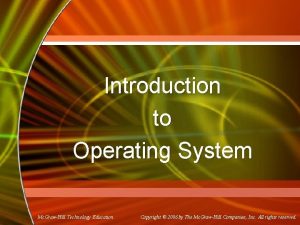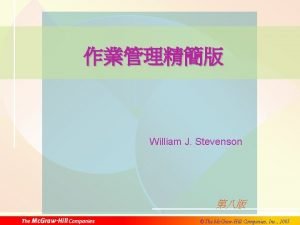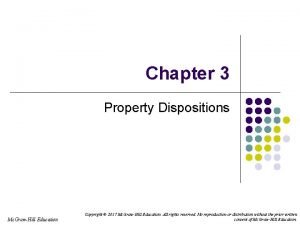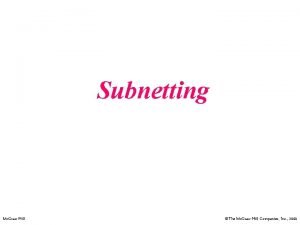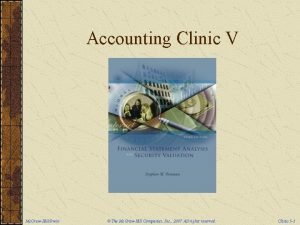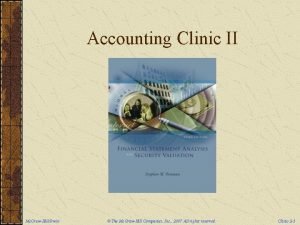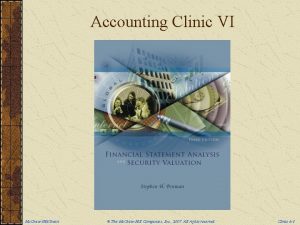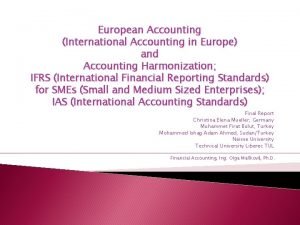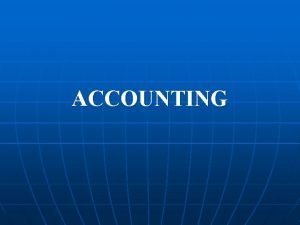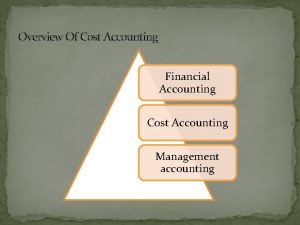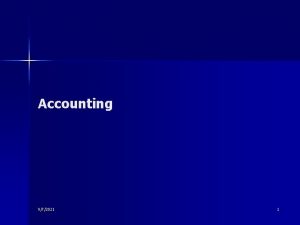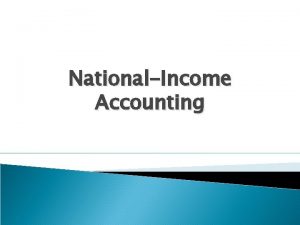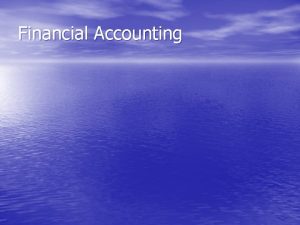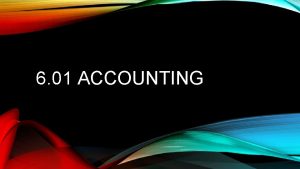Accounting Clinic I Mc GrawHillIrwin The Mc GrawHill








































- Slides: 40

Accounting Clinic I Mc. Graw-Hill/Irwin © The Mc. Graw-Hill Companies, Inc. , 2003 All rights reserved. Clinic 1 -1

Prepared by: Nir Yehuda With contributions by Stephen H. Penman – Columbia University

Introduction Accounting clinic I contains the following: A brief review of the four financial statements Examples of how each financial statement is prepared A summary of the principles of measurement in financial statement Mc. Graw-Hill/Irwin © The Mc. Graw-Hill Companies, Inc. , 2003 All rights reserved. Clinic 1 -3

The Financial Statements 1. Balance Sheet 2. Income Statement 3. Cash Flow Statement 4. Statement of Shareholders’ Equity Mc. Graw-Hill/Irwin © The Mc. Graw-Hill Companies, Inc. , 2003 All rights reserved. Clinic 1 -4

The Balance Sheet: Dell Computer Corporation Mc. Graw-Hill/Irwin © The Mc. Graw-Hill Companies, Inc. , 2003 All rights reserved. Clinic 1 -5

The balance sheet reports the resources the firm controls at a point in time and the claims against those resources. That is, it is a detailed description of the firm's assets, liabilities and owners' equity. Mc. Graw-Hill/Irwin © The Mc. Graw-Hill Companies, Inc. , 2003 All rights reserved. Clinic 1 -6

The Form of the Balance Sheet Assets = Liabilities + Shareholders’ Equity or Shareholders’ Equity = Assets – Liabilities Assets are economic resources that produce future earnings. Liabilities are obligations to transfer assets or provide services to parties other than the owners. Equity is the owners' residual interest in the assets of an entity that remains after deducting the liabilities. Mc. Graw-Hill/Irwin © The Mc. Graw-Hill Companies, Inc. , 2003 All rights reserved. Clinic 1 -7

Example - Balance Sheet Preparation Presented below are selected accounts of Biking Corporation at December 31, 2004: Required: Prepare a classified balance sheet. Mc. Graw-Hill/Irwin © The Mc. Graw-Hill Companies, Inc. , 2003 All rights reserved. Clinic 1 -8

Solution Retained earnings are calculated as a plug number. Mc. Graw-Hill/Irwin © The Mc. Graw-Hill Companies, Inc. , 2003 All rights reserved. Clinic 1 -9

The balance sheet reports assets and the claims on those assets at a point in time. The other three financial statements summarize the effects of transactions and economic events occurring between two balance sheets dates. The income statement reports revenues less expenses (earnings) that increase owners' equity between two balance sheet dates. Mc. Graw-Hill/Irwin © The Mc. Graw-Hill Companies, Inc. , 2003 All rights reserved. Clinic 1 -10

The Income Statement: Dell Computer Corporation Mc. Graw-Hill/Irwin © The Mc. Graw-Hill Companies, Inc. , 2003 All rights reserved. Clinic 1 -11

The Form of the Income Statement Net Revenue – Cost of Goods Sold = Gross Margin – Operating Expenses = Operating Income before Tax (EBIT) Operating Income before Tax – Interest Expense = Income before Taxes – Income Taxes = Income after Taxes (and before Extraordinary Items) Mc. Graw-Hill/Irwin © The Mc. Graw-Hill Companies, Inc. , 2003 All rights reserved. Clinic 1 -12

Example - Income Statement Preparation below are selected ledger accounts of Grant Corporation at December 31, 2005: A physical inventory indicates that the ending inventory is $547, 000. Assume a tax rate of 35%. Required: Prepare a condensed income statement Mc. Graw-Hill/Irwin © The Mc. Graw-Hill Companies, Inc. , 2003 All rights reserved. Clinic 1 -13

Solution (1) 5, 000 -42, 000 (2) 409, 000+(2, 548, 000+81, 000 -31, 000)-547, 000 (3) 257, 000+76, 000+108, 000+58, 000 (4) 282, 000+26, 000+24, 000+62, 000 Mc. Graw-Hill/Irwin © The Mc. Graw-Hill Companies, Inc. , 2003 All rights reserved. Clinic 1 -14

The Statement of Cash Flows : Dell Computer Corporation Mc. Graw-Hill/Irwin © The Mc. Graw-Hill Companies, Inc. , 2003 All rights reserved. Clinic 1 -15

The statement of cash flows explains the change in cash during the period in terms of cash provided by or used for operating, investing and financing activities. Mc. Graw-Hill/Irwin © The Mc. Graw-Hill Companies, Inc. , 2003 All rights reserved. Clinic 1 -16

The Form of the Cash Flow Statement Change in Cash = Cash from Operations + Cash from Investing + Cash from Financing Mc. Graw-Hill/Irwin © The Mc. Graw-Hill Companies, Inc. , 2003 All rights reserved. Clinic 1 -17

The Form of the Cash Flow Statement The primary purpose of a statement of cash flows is to provide relevant information about the cash inflows and outflows of an enterprise during a period. The statement has three main sections: Cash Flows from Investing Activities - Investing activities involve acquiring and disposing of debt or equity investments, property, plant and equipment and other productive assets used in the production of goods or services by the enterprise (other than materials that are part of the enterprise's inventory). Mc. Graw-Hill/Irwin © The Mc. Graw-Hill Companies, Inc. , 2003 All rights reserved. Clinic 1 -18

The Form of the Cash Flow Statement Cash Flows from financing Activities - Financing activities involve obtaining resources from owners and providing them with a return on their investment; borrowing money and repaying amounts borrowed, and obtaining and paying for other resources obtained from creditors on long-term credit. Cash Flows from operating Activities - Operating activities involve all transactions and other events that are not defined as investing or financing. Operating activities generally involve producing and delivering goods and providing services. Cash flows from operating activities are generally the cash effects of transactions and other events that enter into the determination of net income. Mc. Graw-Hill/Irwin © The Mc. Graw-Hill Companies, Inc. , 2003 All rights reserved. Clinic 1 -19

Example – Preparation of a cash flow statement Presented below are the balance sheets of Scientific Instruments, Ltd. for December 31, 2005 and 2004 Mc. Graw-Hill/Irwin © The Mc. Graw-Hill Companies, Inc. , 2003 All rights reserved. Clinic 1 -20

Additional Information: Equipment with original cost of $50 was sold for $35 Dividend declared and paid in cash was $300 Stocks and Bonds were issued for cash Net income reported was $80. Required: Prepare a statement of cash flow for 2005 Note: Cash from operating activities involves adjusting net income for all the non-cash items in net income. Mc. Graw-Hill/Irwin © The Mc. Graw-Hill Companies, Inc. , 2003 All rights reserved. Clinic 1 -21

Solution Mc. Graw-Hill/Irwin © The Mc. Graw-Hill Companies, Inc. , 2003 All rights reserved. Clinic 1 -22

The Statement of Stockholders’ Equity: Dell Computer Corporation Mc. Graw-Hill/Irwin © The Mc. Graw-Hill Companies, Inc. , 2003 All rights reserved. Clinic 1 -23

Shareholder’s Equity has two primary components: contributed capital which represents stockholders’ investment – common stock (par value) and additional paid in capital, and retained earnings which equals cumulative net income minus cumulative dividends since the formation of the company. (Dividends are distributions of assets to stockholders. ) Mc. Graw-Hill/Irwin © The Mc. Graw-Hill Companies, Inc. , 2003 All rights reserved. Clinic 1 -24

Comprehensive Income To avoid earnings fluctuations some of the unrealized gains/losses are reported in “other comprehensive income” and not included in net income. Mc. Graw-Hill/Irwin © The Mc. Graw-Hill Companies, Inc. , 2003 All rights reserved. Clinic 1 -25

Mc. Graw-Hill/Irwin © The Mc. Graw-Hill Companies, Inc. , 2003 All rights reserved. Clinic 1 -26

The Stocks and Flows Equation Ending equity = Beginning equity + Total (comprehensive) income – Net payout to shareholders Comprehensive income = Net income + Other comprehensive income Net payout to shareholders = Dividends + Share issues Mc. Graw-Hill/Irwin repurchases -Share © The Mc. Graw-Hill Companies, Inc. , 2003 All rights reserved. Clinic 1 -27

The Articulation of the Financial Statements Cash Flow Statement Cash from operations Cash from investing Beginning Balance Sheet Ending Balance Sheet Cash from financing Cash Net change in cash + Other Assets Cash + Other Assets Statement of Shareholders’ Equity Total Assets - Liabilities Owners’ equity Investment and disinvestment by owners Net income and other earnings Net change in owners’ equity Total Assets - Liabilities Owners’ equity Income Statement Revenues Expenses Net income Mc. Graw-Hill/Irwin © The Mc. Graw-Hill Companies, Inc. , 2003 All rights reserved. Clinic 1 -28

Principles of Measurement Two types of measurement are used in financial statements Mark-to-market accounting Assets and liabilities are reported at their “fair value” and gains and losses from revaluing them are reported in the income statement or as part of other comprehensive income in the equity statement. Fair value is either market value or an estimate of value. Mc. Graw-Hill/Irwin © The Mc. Graw-Hill Companies, Inc. , 2003 All rights reserved. Clinic 1 -29

Historical cost accounting Assets and liabilities are reported at their historical cost (the dollar amount paid when they were acquired or incurred). In subsequent periods, those costs are amortized to the income statement as the assets are deemed to have been used up in operations or as liabilities accrue costs. GAAP accounting uses both types of measurement. Mc. Graw-Hill/Irwin © The Mc. Graw-Hill Companies, Inc. , 2003 All rights reserved. Clinic 1 -30

Mark-to Market Accounting Under U. S. GAAP, the following assets and liabilities are approximately at market value: Cash and Cash Equivalents Short-term Payables Short-term and Long-term Borrowings Long-term Debt Securities Equity Investments The following assets and liabilities are measured at an estimate of their fair value rather than their market value: Net Accounts Receivables (net of estimate of likely bad debt. ) Accrued and Estimated Liabilities Mc. Graw-Hill/Irwin © The Mc. Graw-Hill Companies, Inc. , 2003 All rights reserved. Clinic 1 -31

Historical Cost Accounting The following assets and liabilities are at (amortized) historical cost on the balance sheet: Long-term Tangible Assets Recorded Intangible Assets Goodwill These assets can be written down if their value is deemed to have been impaired, but are never written up (in the U. S. ). Mc. Graw-Hill/Irwin © The Mc. Graw-Hill Companies, Inc. , 2003 All rights reserved. Clinic 1 -32

Mixed Accounting Measurement The following assets are sometimes measured at historical cost and sometimes at fair values: Inventories: Lower of cost or market rule applies Debt investments • Trading • Available-for-sale • Held to maturity Equity investments • Trading • Available-for-sale See Accounting Clinic III Mc. Graw-Hill/Irwin © The Mc. Graw-Hill Companies, Inc. , 2003 All rights reserved. Clinic 1 -33

Historical Cost Accounting in The Income Statement Revenue recognition principle - value added is recognized when: The earnings process is substantially accomplished Receipt of cash is reasonably certain Matching principle Expenses are recognized in the income statement by their association with revenues for which they are incurred. The earnings number reflects net value added from revenues, that is, net of matched expenses. Go to Accounting Clinic II for more on matching Mc. Graw-Hill/Irwin © The Mc. Graw-Hill Companies, Inc. , 2003 All rights reserved. Clinic 1 -34

Cost of Goods Sold: An Application of Matching Cost of goods sold is an accrual concept, calculated in the following way: Inventory, beginning XXX + Purchases XXX Goods available for sale XXX - Inventory, ending (XXX) Cost of Goods Sold XXX The beginning balance of inventory and purchases of goods during the year sum up to the total goods that the firm could have sold during the year. The ending balance of inventory (usually available from physical count) is subtracted to get the cost of the goods actually sold. Mc. Graw-Hill/Irwin © The Mc. Graw-Hill Companies, Inc. , 2003 All rights reserved. Clinic 1 -35

In the income statement preparation example total purchases were 2, 598, 000 (after adding shipment and subtracting discounts). The beginning of inventory was 409, 000 and the ending of inventory was 547, 000. Therefore total cost of goods sold was: 409, 000+2, 598, 000 -547, 000=2, 460, 000 Mc. Graw-Hill/Irwin © The Mc. Graw-Hill Companies, Inc. , 2003 All rights reserved. Clinic 1 -36

The cash outflow equivalent to the cost of goods sold is payment to suppliers. Accrual accounting performs two main adjustments to this amount to arrive at the cost of goods sold: Accounts Payable adjustment – payment might not reflect the entire expenditure on inventories. Some inventories were purchased on account. Inventory adjustment – inventory is a pure accrual concept and is recognized in order to match the expense (COGS) with revenue (the amount we received for the goods sold). More about the matching concept in Accounting Clinic II. Mc. Graw-Hill/Irwin © The Mc. Graw-Hill Companies, Inc. , 2003 All rights reserved. Clinic 1 -37

R&D accounts: An Example of Poor Matching Peabody Co. produces operating income of $30, 000 from operations each year. The company invested $20, 000 in an R&D project in December 31, 2004. The investment will produce an incremental income of $7, 000 in each of the following 5 years. Calculate operating income for the years 20042009 1. if the firm expenses R&D immediately (as GAAP requires) 2. if the firm capitalizes R&D and amortize it using straight line method. Mc. Graw-Hill/Irwin © The Mc. Graw-Hill Companies, Inc. , 2003 All rights reserved. Clinic 1 -38

Mc. Graw-Hill/Irwin © The Mc. Graw-Hill Companies, Inc. , 2003 All rights reserved. Clinic 1 -39

Fully expensing R&D in the year in which it was incurred results in poor matching in operating income. Mc. Graw-Hill/Irwin © The Mc. Graw-Hill Companies, Inc. , 2003 All rights reserved. Clinic 1 -40
 Mc grawhill
Mc grawhill Grawhill
Grawhill Mc grawhill
Mc grawhill Grawhill
Grawhill Grawhill
Grawhill Single user multitasking os
Single user multitasking os Grawhill
Grawhill Grawhill
Grawhill Grawhill
Grawhill Glasgow thang điểm
Glasgow thang điểm đại từ thay thế
đại từ thay thế Quá trình desamine hóa có thể tạo ra
Quá trình desamine hóa có thể tạo ra Công thức tính thế năng
Công thức tính thế năng Thế nào là mạng điện lắp đặt kiểu nổi
Thế nào là mạng điện lắp đặt kiểu nổi Các loại đột biến cấu trúc nhiễm sắc thể
Các loại đột biến cấu trúc nhiễm sắc thể Bổ thể
Bổ thể Vẽ hình chiếu đứng bằng cạnh của vật thể
Vẽ hình chiếu đứng bằng cạnh của vật thể độ dài liên kết
độ dài liên kết Các môn thể thao bắt đầu bằng tiếng đua
Các môn thể thao bắt đầu bằng tiếng đua Thiếu nhi thế giới liên hoan
Thiếu nhi thế giới liên hoan Khi nào hổ con có thể sống độc lập
Khi nào hổ con có thể sống độc lập điện thế nghỉ
điện thế nghỉ Một số thể thơ truyền thống
Một số thể thơ truyền thống Thế nào là sự mỏi cơ
Thế nào là sự mỏi cơ Trời xanh đây là của chúng ta thể thơ
Trời xanh đây là của chúng ta thể thơ Bảng số nguyên tố lớn hơn 1000
Bảng số nguyên tố lớn hơn 1000 Vẽ hình chiếu vuông góc của vật thể sau
Vẽ hình chiếu vuông góc của vật thể sau Tỉ lệ cơ thể trẻ em
Tỉ lệ cơ thể trẻ em Các châu lục và đại dương trên thế giới
Các châu lục và đại dương trên thế giới Thế nào là hệ số cao nhất
Thế nào là hệ số cao nhất Sơ đồ cơ thể người
Sơ đồ cơ thể người Tư thế ngồi viết
Tư thế ngồi viết Cái miệng bé xinh thế chỉ nói điều hay thôi
Cái miệng bé xinh thế chỉ nói điều hay thôi Hình ảnh bộ gõ cơ thể búng tay
Hình ảnh bộ gõ cơ thể búng tay đặc điểm cơ thể của người tối cổ
đặc điểm cơ thể của người tối cổ Cách giải mật thư tọa độ
Cách giải mật thư tọa độ Tư thế ngồi viết
Tư thế ngồi viết ưu thế lai là gì
ưu thế lai là gì Gấu đi như thế nào
Gấu đi như thế nào Thẻ vin
Thẻ vin Thơ thất ngôn tứ tuyệt đường luật
Thơ thất ngôn tứ tuyệt đường luật

